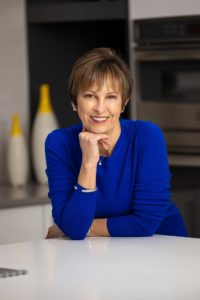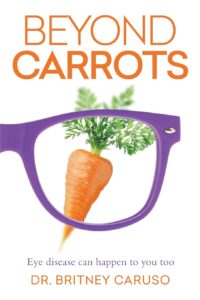Britney Caruso, OD, FAARM, FMNM, was 35 years old and had been working full-time for a decade. She lived an active lifestyle, her health was superb and her business was booming.


She made an appointment with an ophthalmologist immediately. She didn’t know what to think; she had 20/20 vision and no symptoms. The damage, invisible without fluorescein and difficult to see even with traditional dilation, was worsening by the day. She visited several other ophthalmologists that month while trying to figure out her best course of action. She had the back of her eyes lasered and was put on heavy steroids, but she knew it wasn’t a long-term solution.
She was told she’d be blind within six months.
Dr. Caruso, justifiably, was devastated. “I knew I would remember that day forever,” she says. Her tears were yellow as she left the office, tinted by the dye. She was diagnosed with peripheral retina vasculitis, an uncommon disease causing idiopathic inflammatory venous occlusion, known to affect young and otherwise healthy adults.
“I had never experienced the fear of possibly going blind,” she says. “I had been practicing for years, and I suddenly wasn’t sure I would be able to perform eye exams anymore. How do you reinvent yourself as a blind optometrist?”
She spent the following days researching to learn about possible solutions. She changed her diet, exercise routine and supplement intake, and she brought the plan to her doctor- who wasn’t too sure it would work. Her doctor agreed to her plan with a limit: 30 days. If she didn’t show improvement in that time, they would move forward with other measures.
30 days later, after a total life transformation, Dr. Caruso’s leakage was gone.
NEW HOBBIES, NEW HABITS: A LIFE PIVOT
Dr. Caruso found that an anti-inflammatory diet worked wonders in reversing her eye damage. She couldn’t believe how much of a difference she made for her vision by simply changing her daily habits. Once she had evidence that her protocol worked, and believing that it could work for others, she wanted to find a way to shout it to the masses.
“I wanted to become as informed as possible in the nutrition field. I became one of three optometrists in the nation with a fellowship in Anti-Aging and Regenerative Medicine and a fellowship in Metabolic and Nutritional Medicine.
“My least favorite thing to do was write,” Dr. Caruso says of herself as a child. But now, decades later, she believed it was the best and most organized way to share her story with others and potentially help others reverse their eye disease, too.
Dr. Caruso’s book, Beyond Carrots: Eye disease can happen to you too, hit the shelves of Barnes & Noble and Amazon in May 2022.


Beyond Carrots dives deeply into her personal story as an OD whose life was suddenly on “a downward spiral,” she says. “The struggle of facing losing my vision was a blessing. Now I can help others so that they don’t experience this.”
Dr. Caruso now has a clean bill of health. She continues to manage her daily habits actively to ensure she is making the healthiest choices possible. She brings this same level of care to the patients at her two Caruso Eye Care locations in Florida, where retinal imaging is standard practice for all patients.
Dr. Caruso’s findings and personal journey affected the way she cares for patients from here on out. She now makes it a point to discuss the effects that nutrition and lifestyle have on eye health, regardless of the patient’s health assessment or risk, because she knows better than most that it can happen to anyone.
For those looking to learn more about how to best care for their eyes, Dr. Caruso encourages people to talk to a doctor and not be afraid to ask questions. She recommends finding a provider with in-office imaging and says getting screened annually is “an absolute must for all patients, regardless of what your vision or health risk is.” She also recommends asking for widefield retinal imaging to be a part of the eye exam. “Patients should get their eyes checked annually, even if they are healthy,” she says.



